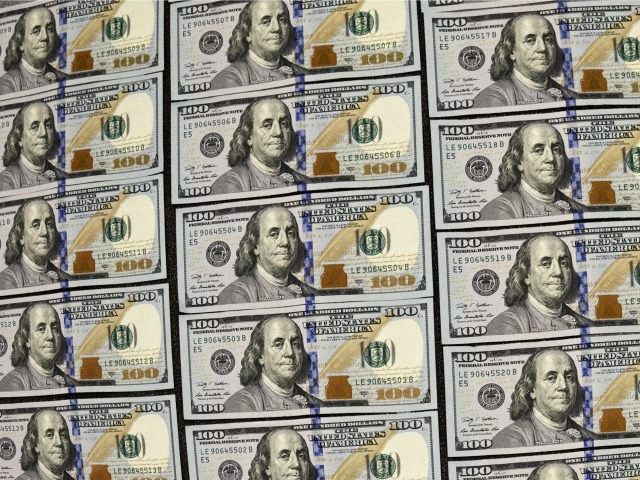The strong dollar continues to drag down U.S. growth, complicating the Federal Reserve’s plans to raise interest rates and casting serious doubts on President Obama’s proposed free trade agreement with Asian nations.
The Commerce Department reported first quarter GDP was down 0.7 percent. The severe winter put the skids on new home construction and falling oil prices nixed investments in structures and equipment. Along with the now ended West Coast strike, those will impose less drag on the economy in the second quarter.
Whereas the strong dollar—precipitated by aggressive monetary policies in Japan, South Korea, China, and Europe that target currency exchange rates for the dollar—will have enduring and substantial negative consequences for growth.
In the first quarter alone, lost exports subtracted 1.0 percentage points from growth and increased imports stole another 0.9.
The Federal Reserve has already postponed raising interest rates until the fall, and built into my forecast is a first move toward normalizing rates in the third quarter.
| Quarterly Forecasts (percent) | |||||||||
| Q115 | Q215 | Q315 | Q415 | Q116 | Q216 | 2014 | 2015 | 2016 | |
| GDP: Annual | -0.7 | 2.1 | 2.8 | 2.6 | 2.8 | 2.8 | 2.4 | 2.1 | 2.7 |
| GDP: Q4/Q4 | 2.4 | 1.7 | 2.8 | ||||||
| CPI: Year/Year | -0.1 | -0.2 | 0.2 | 1.1 | 1.6 | 1.8 | 1.6 | 0.3 | 1.7 |
| Core CPI: Y/Y | 1.7 | 1.8 | 1.9 | 2.1 | 2.1 | 2.0 | 1.7 | 1.9 | 2.0 |
| Unemployment Rate | 5.5 | 5.4 | 5.3 | 5.2 | 5.1 | 5.0 | 6.2 | 5.4 | 4.8 |
| Fed Funds: End Qtr | 0.125 | 0.125 | 0.250 | 0.75 | 1.25 | 1.75 | |||
| S&P Case Shiller: Y/Y | 7.9 | 8.5 | 8.0 | ||||||
| Housing Starts (MM) | 1.00 | 1.10 | 1.20 | ||||||
| Light Vehicles (MM) | 16.4 | 16.9 | 17.1 | ||||||
| Retail Sales: Nominal | 3.9 | 2.1 | 4.6 | ||||||
| Retail Sales: Real | 2.3 | 1.8 | 2.9 | ||||||
| Crude Oil (Brent) $ | 99 | 62 | 69 | ||||||
| Crude Oil (Cushing) $ | 93 | 57 | 64 | ||||||
Stronger household balance sheets, robust interest in new automobiles with better gas mileage and other advanced features, and a pickup in new home construction should boost growth to about 2.8 percent by the third or fourth quarter. However, that would be well short of the 4 or 5 percent growth the economy could accomplish given the large numbers of underemployed recent college graduates and the 7 million men ages 25 to 54 that are jobless and not seeking employment.
The headwinds created by beggar-thy-neighbor foreign monetary policies and a strong dollar will persist and complicate Fed efforts to “normalize” interest rates, which it currently views as raising the overnight bank borrowing rate (federal funds rate) from its current 0.125 percent to 3.75 percent.
More likely, efforts to raise interest rates, however gradually, will stall at about 2 percent or less without some kind of international effort to more reasonably revalue the dollar. A good start would be a currency agreement within the proposed Trans-Pacific Partnership.
Unless new free trade agreements significantly reduce the $400 billion U.S. trade deficit with Asia, it is tough to see those benefiting growth. Asian participants can simply overwhelm the benefits to U.S. businesses from lower barriers to trade and investment barriers by printing money to cheapen their currencies.
The Obama economic policy has emphasized income redistribution—for example through expansion of Food Stamps and Medicaid, and Obamacare subsidies for many middle class families—and the recent recovery has averaged only 2.2 percent annual growth. Whereas during the Reagan-Clinton years, greater emphasis was placed on keeping the dollar fairly valued and redressing trade imbalances—for example with Japan—and the economy grew at a 3.4 percent pace.
The president has flat out rejected addressing currency issues in TPP negotiations and recommendations from economists on the right, left, and in the center to more fairly value the dollar and boost growth. The Fed has refused to comment on the limitations imposed on its policy options by the administration’s recalcitrant attitude that rejects basic tenants of modern international macroeconomics.
The country must wait for a new president and a new Fed Chairman to see a substantial improvement in growth. Meanwhile, wages and real incomes for ordinary working Americans will languish.
Peter Morici is an economist and business professor at the University of Maryland, and a national columnist. He tweets @pmorici1.

COMMENTS
Please let us know if you're having issues with commenting.